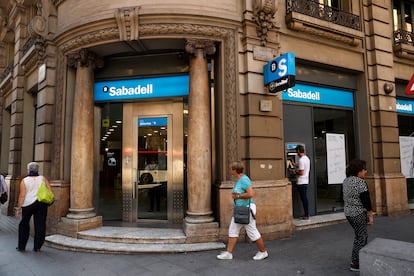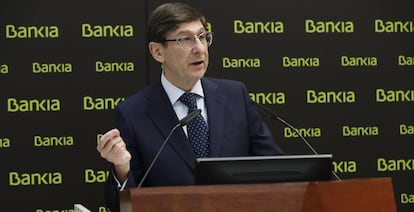BBVA-Sabadell merger talks cap decade of forced consolidation for Spanish banks
The tie-ups and acquisitions taking place in Spain since 2009 are unmatched elsewhere in Europe

Spain’s BBVA bank and the smaller Sabadell are in talks for a potential merger that would create a lender with €860 billion in global assets, deducting the upcoming sale of BBVA’s US division.
Sources familiar with the negotiation told EL PAÍS that high-level talks resumed last week ahead of the imminent sale of BBVA USA, a Texas-based subsidiary with $104 billion in assets that operates 637 branches in that country.
The Spanish banking sector is now going through three simultaneous merger processes. The first one is the tie-up deal for €4.3 billion announced in September by CaixaBank and Bankia – itself the result of an earlier merger of several regional savings banks – and which is expected to be completed by March 2021. But it is not just the giant lenders who are joining forces: the smaller Unicaja and Liberbank are in talks as well.

These moves illustrate the growing consolidation of Spain’s banking sector as it struggles to deal with historically low interest rates and the economic impact of the coronavirus pandemic. Two weeks ago, Sabadell said it would fire 1,800 employees, representing 11% of its staff.
Not so long ago, reciting from memory all the lenders operating in Spain was a feat that only industry experts could pull off. But one decade and two major crises later, that list has been shortened from 55 in 2009 to around a dozen today (see box below).
Pressure to consolidate has been coming from all sides. The European Central Bank (ECB) has been insisting that in a recession scenario with low interest rates, there is no room for superfluous expenses. “Before Covid-19 it was very important to adjust costs and eliminate excess capacity; now, with the pandemic, those moves have become indispensable,” said ECB Vice-President Luis de Guindos two-and-a-half months ago. And Bank of Spain Governor Pablo Hernández de Cos said last month that he could still see room for mergers without compromising competitiveness.
Analysts have been warning for some time that this would come to pass. “The disproportionate capital demands by the ECB foretell [a period of] mergers and acquisitions that will leave only five or six entities in the Spanish system,” reads a January report on the challenges of the financial sector drafted by the stock market analysis group Instituto de Estudios Bursátiles.
Europe’s biggest restructuring process
The overarching conclusion is that Spanish banking, increasingly focused on its digital business, will continue to undergo the biggest restructuring process in Europe. This has been evident in the number of layoffs: besides Sabadell’s recent announcement, Santander last week decided to put 4,000 workers on an ERTE job retention scheme.
In 12 years, the Spanish banking sector has closed 50% of its branch offices and fired more than 115,000 workers, representing 37% of its workforce. At the peak of the industry’s golden era, in 2008, there were 276,497 people working for banks.
The savings banks were the first to go under, due to their smaller buffers of capital and to widespread mismanagement. The 2017 acquisition of Banco Popular by Santander and the 2012 bailout of Bankia were some of the key moments in an ongoing story of lender distress and consolidation that is currently entering a new chapter.
A decade of mergers
In just one decade, Bankia was formed out of the merger of seven regional savings banks (Caja Madrid, Bancaja, Caja de Ávila, Caja Segovia, Caja La Rioja, Caja Laietana, and Caja Insular de Canarias). The lender later added Caja Murcia, Caixa Penedès, Caja Granada and Sa Nostra, which had themselves joined forces to create Mare Nostrum (BMN).
Meanwhile, BBVA acquired six other savings banks: Caixa Sabadell, Caixa Terrasa and Caixa Manlleu, which had by then formed a group called Unnim, on one hand; and Caixa Catalunya, Caixa Tarragona and Caixa Manresa, which worked under the collective name Catalunya Banc, on the other.
Another giant lender, La Caixa, assimilated seven more regional savings banks: Caixa Girona, Banco de Valencia and Banca Cívica, itself a merger of Caja Sol, Caja Guadalajara, Caja Navarra, Caja Burgos and Caja Canarias. And Spain’s other major player, Santander, acquired Banco Popular and Banco Pastor.
English version by Susana Urra.
Tu suscripción se está usando en otro dispositivo
¿Quieres añadir otro usuario a tu suscripción?
Si continúas leyendo en este dispositivo, no se podrá leer en el otro.
FlechaTu suscripción se está usando en otro dispositivo y solo puedes acceder a EL PAÍS desde un dispositivo a la vez.
Si quieres compartir tu cuenta, cambia tu suscripción a la modalidad Premium, así podrás añadir otro usuario. Cada uno accederá con su propia cuenta de email, lo que os permitirá personalizar vuestra experiencia en EL PAÍS.
¿Tienes una suscripción de empresa? Accede aquí para contratar más cuentas.
En el caso de no saber quién está usando tu cuenta, te recomendamos cambiar tu contraseña aquí.
Si decides continuar compartiendo tu cuenta, este mensaje se mostrará en tu dispositivo y en el de la otra persona que está usando tu cuenta de forma indefinida, afectando a tu experiencia de lectura. Puedes consultar aquí los términos y condiciones de la suscripción digital.
More information
Últimas noticias
Trump claims peace in Ukraine is near, but Moscow suggests otherwise
A survivor’s account of the Interoceanic Train accident: ‘We were scared because of the speed on the curve’
The Interoceanic Train, the Mexican alternative to the Panama Canal
What is known about the Interoceanic Train derailment in Oaxaca
Most viewed
- Oona Chaplin: ‘I told James Cameron that I was living in a treehouse and starting a permaculture project with a friend’
- Reinhard Genzel, Nobel laureate in physics: ‘One-minute videos will never give you the truth’
- Why the price of coffee has skyrocketed: from Brazilian plantations to specialty coffee houses
- Pablo Escobar’s hippos: A serious environmental problem, 40 years on
- Chevy Chase, the beloved comedian who was a monster off camera: ‘Not everyone hated him, just the people who’ve worked with him’










































